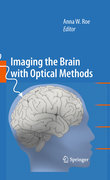
The technology of detecting and interpreting patterns of reflected light has reached a remarkable degree of maturity that now permits high spatial and temporal resolution visualization at both the systems and cellular levels. There now exist several optical imaging methodologies, based on either hemodynamic changes in nervous tissue or neurally-induced light scattering changes, that canbe used to measure ongoing activity in the brain. In two parts, Imaging the Brain with Optical Methods discusses the history of optical imaging and its usein the study of brain function, and the rapidly developing optical technologies and their applications that have recently developed. These include intrinsic signal optical imaging, near-infrared optical imaging, fast optical imaging based on scattered light, optical imaging with voltage sensitive dyes, and 2 photon imaging of hemodynamic signals. In total, this volume will encapsulate the current state of optical imaging methodologies and their contribution towards understanding the spatial and temporal organization of cerebral cortical function. INDICE: The hemodynamic signal and neural activity, or Diffusion Tensor Imaging.- Vision.- Somatosensory: Imaging Tactile Perception.- Auditory: ImagingSound Maps.- Parietal: Imaging Gaze Direction.- Inferotemporal: Imaging Objects.- Inferotemporal: Imaging Faces.- Prefrontal: Imaging working memory.- Neural development and plasticity.- Optical imaging in intraoperative setting in humans.- Near Infrared Imaging in Human infants.- Optical imaging with voltage sensitive dyes.- Fast optical imaging based on scattered light.- 2 photon imaging of hemodynamic signals.- Optical Coherence Tomography.
- ISBN: 978-1-4419-0451-5
- Editorial: Springer
- Encuadernacion: Cartoné
- Páginas: 392
- Fecha Publicación: 01/10/2009
- Nº Volúmenes: 1
- Idioma: Inglés
